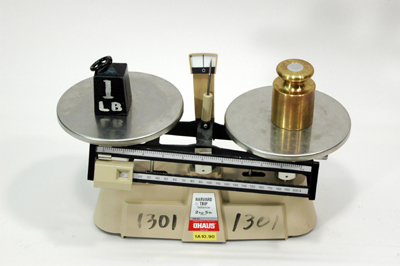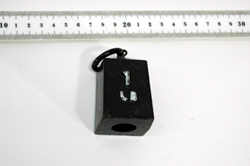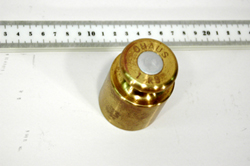|
Size: 1261
Comment:
|
Size: 2561
Comment:
|
| Deletions are marked like this. | Additions are marked like this. |
| Line 2: | Line 2: |
| ||<:30%>[:PiraScheme#Mechanics: Table of Mechanics Demonstration]||<:30%>[:MEEquipmentList: List of Mechanics Equipment & Supplies]||<:30%>[:Demonstrations:Lecture Demonstrations]|| | ||<30% style="text-align:center">[[PiraScheme#Mechanics|Table of Mechanics Demonstration]] ||<30% style="text-align:center">[[MEEquipmentList|List of Mechanics Equipment & Supplies]] ||<30% style="text-align:center">[[Demonstrations|Lecture Demonstrations]] || |
| Line 5: | Line 6: |
| '''Topic and Concept:''' . Measurement, [[Measurement|1A10. Basic Units]] '''A PIRA-200 Item''' |
|
| Line 7: | Line 13: |
| * '''Cabinet:''' [:MechanicsCabinet:Mechanic (ME)] * '''Bay:''' [:MechanicsCabinetBayA3:(A3)] |
* '''Cabinet:''' [[MechanicsCabinet|Mechanic (ME)]] * '''Bay:''' [[MechanicsCabinetBayA3|(A3)]] |
| Line 11: | Line 18: |
| attachment:StandardMasses-03-400.jpg | {{attachment:BasicUnits-03-400.jpg}} |
| Line 13: | Line 20: |
| '''Description:''' | '''Abstract:''' |
| Line 15: | Line 22: |
| Compare a 1 lb mass to a 1 kg mass. | Show students a 1 lb mass and a 1 kg mass. ||<40% style="text-align:center">'''Equipment''' ||<30% style="text-align:center">'''Location''' ||<25% style="text-align:center">'''ID Number''' || || || || || ||1 lb Mass ||ME, Bay [[MechanicsCabinetBayA3|A3]], Shelf #1 || || ||1 kg Mass ||ME, Bay [[MechanicsCabinetBayB1|B1]], Shelf #3 || || ||Double Pan Balance ||ME, Bay [[MechanicsCabinetBayB2|B2]], Shelf #2 || || ||Standard Mass Set ||ME, Bay [[MechanicsCabinetBayA1|A1]], Shelf #4 ||[[StandardMassSet|1A10.21]] || |
| Line 17: | Line 30: |
| ||<:style="width: 60%" :40%>'''Equipment'''||<:30%>'''Location'''||<:25%>'''ID Number'''|| || || || || ||1 lb Mass||ME, Bay [:MechanicsCabinetBayA3:A3], Shelf #1|| || ||1 kg Mass||ME, Bay [:MechanicsCabinetBayB1:B1], Shelf #3|| || ||Double Pan Balance||ME, Bay [:MechanicsCabinetBayB2:B2], Shelf #2|| || |
|
| Line 23: | Line 31: |
| '''''Important Setup Notes:''''' '''Setup:''' |
|
| Line 27: | Line 32: |
| 1. N/A | '''''Important Setup Notes:''''' * N/A '''Setup and Procedure:''' 1. Set out the above equipment. 1. Compare the 1 lb mass to a 1 kg mass, by placing the one pound mass on a balance with the equivalent mass in grams on the other side. |
| Line 30: | Line 43: |
| 1. N/A | |
| Line 32: | Line 44: |
| * N/A | |
| Line 33: | Line 46: |
| '''Demonstration:''' | '''Discussion:''' |
| Line 37: | Line 50: |
| ||attachment:1LBMass-01-250.jpg||attachment:KGMass-02-250.jpg|| | The SI unit of mass, the kilogram, is defined as the mass of a specific platinum iridium alloy cylinder kept at the International Bureau of Weights and Measures at Sevres, France. This mass standard was established in 1901, and there has been no change since that time because platinum iridium is an unusually stable alloy. The Sevres cylinder is 3.9 centimeters in diameter and 3.9 centimeters in height. A duplicate is kept at the National Bureau of Standards in Gaithersburg, Md. || {{attachment:StandardMasses-03-250.jpg}} || {{attachment:1LBMass-01-250.jpg}} || {{attachment:KGMass-02-250.jpg}} || '''Videos:''' * [[https://www.youtube.com/user/LectureDemostrations/videos?view=1|Lecture Demonstration's Youtube Channel]] |
| Line 41: | Line 62: |
| 1. List any references | * [[http://www.nist.gov/index.html|National Institute of Standards and Technology's web site]] |
| Line 43: | Line 64: |
[:Instructional:Home] |
[[Instructional|Home]] |
Standard Masses, 1A10.20
Topic and Concept:
Measurement, 1A10. Basic Units
A PIRA-200 Item
Location:
Cabinet: Mechanic (ME)
Bay: (A3)
Shelf: #1

Abstract:
Show students a 1 lb mass and a 1 kg mass.
Equipment |
Location |
ID Number |
|
|
|
1 lb Mass |
ME, Bay A3, Shelf #1 |
|
1 kg Mass |
ME, Bay B1, Shelf #3 |
|
Double Pan Balance |
ME, Bay B2, Shelf #2 |
|
Standard Mass Set |
ME, Bay A1, Shelf #4 |
Important Setup Notes:
- N/A
Setup and Procedure:
- Set out the above equipment.
- Compare the 1 lb mass to a 1 kg mass, by placing the one pound mass on a balance with the equivalent mass in grams on the other side.
Cautions, Warnings, or Safety Concerns:
- N/A
Discussion:
A 1 lb mass and a 1 kg mass is set out for the students to compare. One can use a double pan balance to compare there mass.
The SI unit of mass, the kilogram, is defined as the mass of a specific platinum iridium alloy cylinder kept at the International Bureau of Weights and Measures at Sevres, France. This mass standard was established in 1901, and there has been no change since that time because platinum iridium is an unusually stable alloy. The Sevres cylinder is 3.9 centimeters in diameter and 3.9 centimeters in height. A duplicate is kept at the National Bureau of Standards in Gaithersburg, Md.
|
|
|
Videos:
References:


